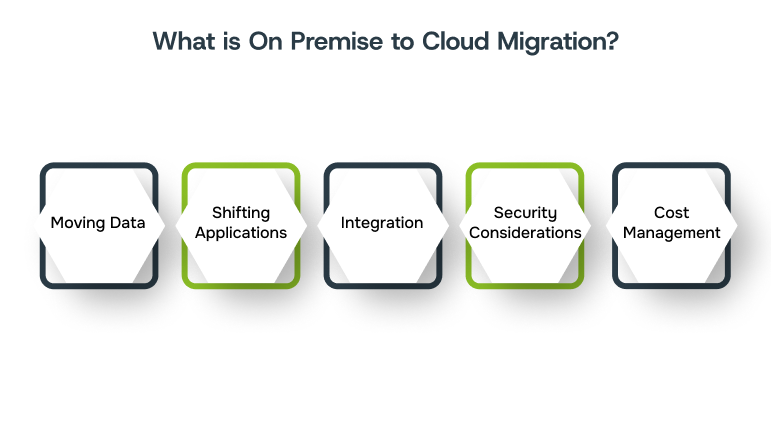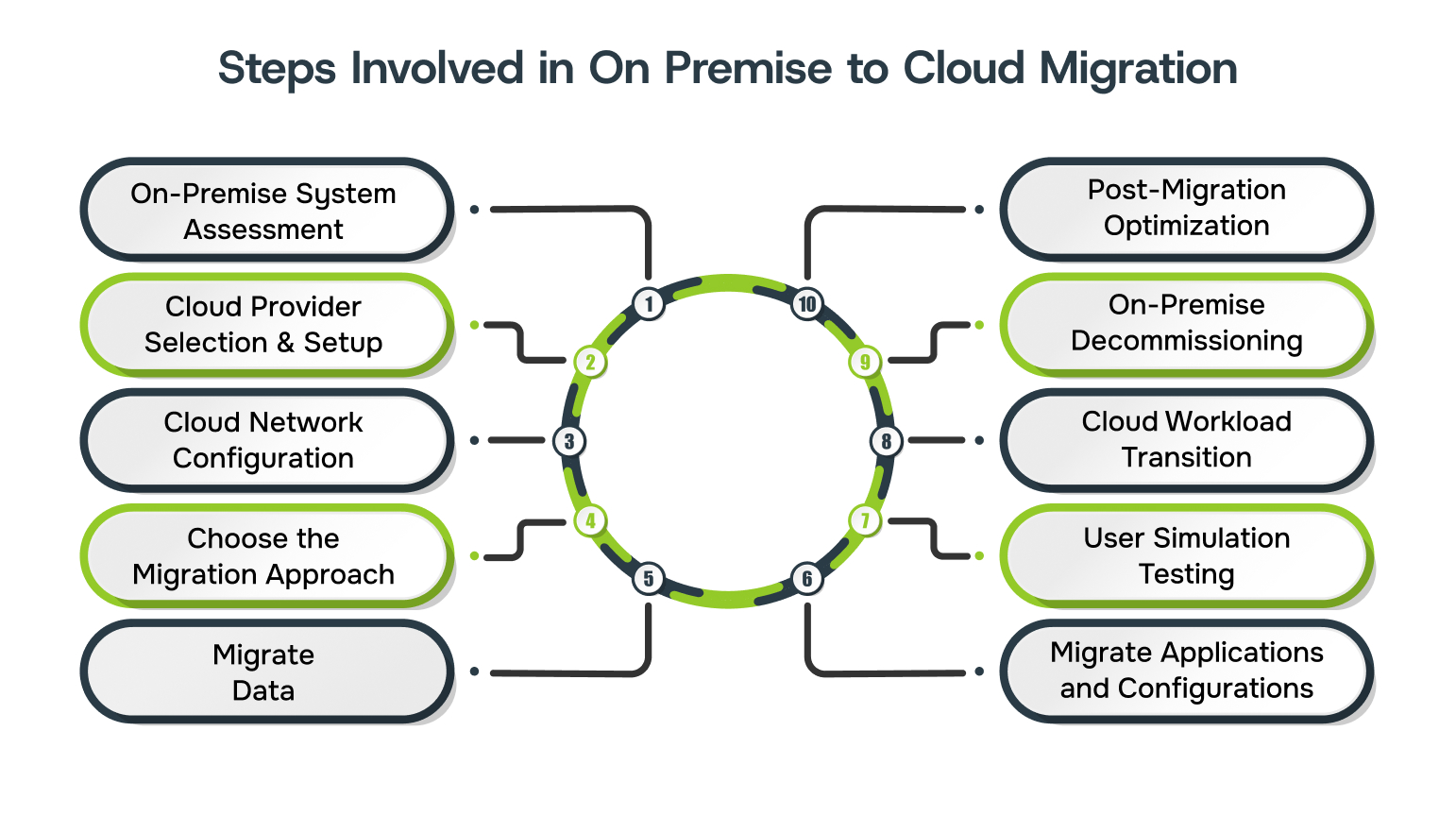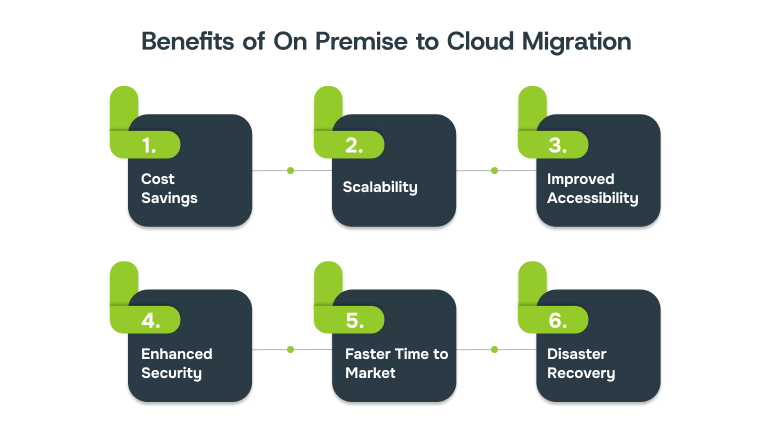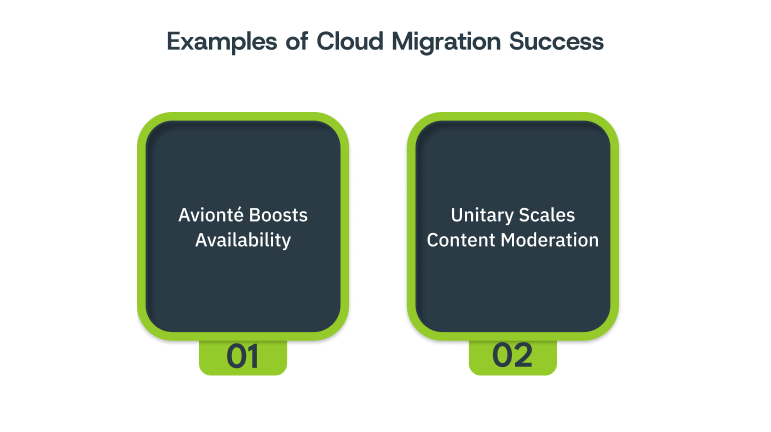On-Premise to Cloud Migration: Step-by-Step Guide
Streamline your on premise to cloud migration: assess your IT environment, define goals, choose the right model, and execute securely. Start today!

Are you finding it hard to manage your business’s growing infrastructure? With 48%of companies migrating at least half of their applications and 20% completing the full transition, moving operations to the cloud is becoming the norm.
Transitioning from on-premise to cloud can seem daunting, but the benefits, such as improved scalability and reduced costs, are hard to ignore. If you’re considering making the shift, this guide will walk you through each step of the process.
We’ll help you understand the key challenges, offer practical solutions, and ensure that your migration is smooth, efficient, and aligned with your business goals.
TL;DR
- Cloud migration offers businesses scalability, cost-efficiency, and enhanced security.
- Key steps include assessing your current environment, defining migration goals, and selecting the right strategy.
- Thorough planning, risk management, and testing are essential to ensure a smooth transition.
- Effective migration requires careful selection of cloud models, providers, and tools based on business needs.
- Post-migration, continuous optimization, monitoring, and support ensure long-term success.
What is On Premise to Cloud Migration?

On-premise to cloud migration is the process of moving your company’s data, applications, and services from physical servers or local infrastructure to a cloud environment. This shift allows businesses to take advantage of cloud benefits such as scalability, cost-efficiency, and better access to modern technologies.
Here’s a closer look at what the migration process involves:
- Moving Data: Effortlessly migrate your business-critical data to the cloud, ensuring faster retrieval and better data management.
- Shifting Applications: Move your business applications to the cloud to enhance accessibility and improve operational agility.
- Integration: Seamlessly connect cloud and on-premise systems, enabling smoother workflows and avoiding silos.
- Security Considerations: Protect sensitive data with advanced encryption methods while staying fully compliant with industry regulations.
- Cost Management: Cut the ongoing costs of physical hardware management, freeing up budget for innovation and scalability.
Each business has unique needs, and selecting the appropriate migration strategy ensures a smooth, efficient transition.
What are Different Cloud Migration Strategies?
Cloud migration strategy is shaped by your company’s existing infrastructure, objectives, and risk appetite. Whether you’re looking for a gradual shift or a complete overhaul, selecting the right strategy will ensure minimal disruption, optimise resources, and unlock the full potential of the cloud.
- Rehosting (Lift and Shift): It involves moving your applications and data to the cloud as-is without altering the architecture. It is used when the goal is to quickly get to the cloud with minimal upfront investment.Example: Move a legacy application to the cloud to save on hardware and data centre costs without changing its architecture.
- Replatforming (Lift, Tinker, and Shift): It makes slight modifications to the application, such as changing the database or integrating cloud-native services, without fully refactoring the system.Example: Migrate an app to a cloud platform and replace the on-premise database with a cloud-based database service like Amazon RDS.
- Repurchasing (Drop and Shop): Abandoning your current applications and switching to a cloud-native or SaaS solution. This is often done when legacy systems are too costly or inefficient to migrate.Example: Transition from an on-premise CRM solution to a cloud-based CRM like Salesforce or HubSpot.
- Refactoring (Re-architecting): It involves rebuilding the application to take full advantage of cloud services. This is ideal for organisations aiming for long-term cloud optimisation but requires significant investment in time and resources.Example: Rebuild a legacy ERP system to operate natively in the cloud using microservices and cloud-based storage.
- Retiring: Outdated applications that no longer serve a business need are decommissioned. This happens during cloud migration when certain apps are no longer required in the cloud environment.Example: Decommission an old internal communication system when migrating to a fully cloud-based team collaboration tool like Microsoft Teams.
- Retaining: Retaining keeps certain applications on-premises due to business requirements, regulatory reasons, or cost considerations. These applications are not moved to the cloud but are integrated with cloud services as needed.Example: Retain an on-premise legacy system while moving all other applications to the cloud, ensuring that both systems can work together via secure APIs.
- Phased Migration: It involves migrating applications and workloads to the cloud in stages. This reduces risk by allowing businesses to test and adjust before migrating all systems.Example: Start by migrating non-essential systems, such as development environments, then move customer-facing applications like CRM and ERP in later phases.
Ready to move to the cloud with custom solutions? Contact Alberon to see how our custom software development can streamline your migration.
After selecting the right cloud migration strategy, the next step is to understand the key actions required to ensure a smooth transition.
What are the Steps Involved in On Premise to Cloud Migration?

Migrating from on-premise to the cloud involves strategic planning to align your goals with the right cloud solution. It’s crucial to evaluate your business requirements, prepare for potential roadblocks, and ensure your team is equipped to manage the change.
Here are the steps involved in on premise to cloud migration:
Step 1: Inventory and Assessment of On-Premise Systems
Assess your current infrastructure to identify which systems, applications, and data need to be migrated to the cloud. This step ensures you understand dependencies, workloads, and systems that require upgrades.
- List all on-premise applications and their configurations.
- Identify outdated systems and technical debt that need attention before migration.
- Use migration assessment tools (e.g., Azure Migrate, AWS Migration Hub) to evaluate cloud readiness.
Step 2: Select the Cloud Service Provider and Setup Environment
Choose the appropriate cloud service provider based on your company’s requirements, such as performance, scalability, and compliance needs. Set up your cloud environment accordingly.
- Choose between AWS, Azure, or Google Cloud based on specific business needs.
- Configure essential resources like virtual machines, storage, and network settings.
- Set up security controls and user access for a seamless transition.
Step 3: Configure Network and Connectivity for Cloud Access
Establish secure connectivity between on-premise systems and the cloud to ensure smooth data transfer and operational continuity.
- Set up VPN or Direct Connect (AWS) for secure communication between on-premise infrastructure and cloud resources.
- Test the connection to ensure smooth data flow and no interruptions.
- Ensure network speed and bandwidth are suitable for the migration process.
Step 4: Choose the Migration Approach
Decide on the migration approach (e.g., Lift and Shift, Re-platforming, Refactoring) based on the application’s complexity, cost, and performance requirements.
- For Lift and Shift, move the application as-is to the cloud.
- For Re-platforming, upgrade components (e.g., database) while maintaining the application’s core structure.
- For Refactoring, rebuild the app to leverage cloud-native features.
Step 5: Migrate Data
Move your data to the cloud in a structured and secure manner. Minimise downtime by migrating in batches or during off-peak hours.
- Use cloud migration tools (e.g., AWS DataSync, Azure Blob Storage) to securely transfer data.
- Test data integrity and accessibility after each batch migration.
- Ensure data is properly secured during transfer using encryption.
Step 6: Migrate Applications and Configurations
Migrate your applications to the cloud, ensuring that configurations and dependencies are maintained during the move.
- Install applications in the cloud as per the chosen migration approach.
- Verify that all dependencies (e.g., database connections, external APIs) are correctly configured in the new cloud environment.
- Test each application’s performance in the cloud environment to ensure seamless functionality.
Step 7: Test Cloud Environment with User Simulation
Before fully transitioning, simulate real user traffic to identify potential issues and ensure performance standards are met.
- Run load testing and stress testing to evaluate the application’s performance.
- Check for compatibility issues that may arise when operating in the cloud environment.
- Adjust settings based on feedback from the testing phase to optimise performance.
Step 8: Transition Production Workloads to the Cloud
Gradually cut over production workloads to the cloud, starting with less critical systems. Monitor each transition phase closely.
- Begin with non-critical systems to test and mitigate any issues during the migration.
- Shift critical systems once confidence is gained in the cloud setup.
- Ensure real-time monitoring and quick troubleshooting during the cutover.
Step 9: Decommission On-Premise Infrastructure
Once cloud systems are stable, decommission your old on-premise infrastructure to save costs and reduce complexity.
- Safely wipe data from legacy systems to ensure compliance with data protection regulations.
- Dispose of or repurpose hardware that is no longer needed.
- Record all decommissioned assets for auditing purposes.
Step 10: Validate, Optimise, and Monitor Post-Migration
After migration, test your applications and data in the cloud to ensure they meet performance, security, and functionality requirements. Optimise resources for cost-efficiency and set up monitoring tools.
- Verify that applications and data work as expected in the cloud, meeting security and performance standards.
- Fine-tune cloud settings to improve performance and reduce costs.
- Implement monitoring tools and establish support processes for ongoing maintenance and optimisation.
Migrating to the cloud is just the start. Without proper training, security risks remain. Alberon’s cybersecurity training ensures your team is ready to protect your cloud environment.
The steps for migrating to the cloud are crucial, but understanding the benefits will help you see how this transition can truly transform your business.
Benefits of On Premise to Cloud Migration

Migrating from on-premise to the cloud transforms your business by increasing flexibility and reducing dependency on physical infrastructure. This shift drives efficiency, cost savings, and fosters innovation. It empowers businesses to adapt quickly and scale as needed, ensuring long-term growth.
Here are the benefits provided by cloud migration.
- Cost Savings: Businesses can pay a fixed subscription fee, avoiding large capital expenses required for server upgrades.
- Scalability: Cloud solutions enable businesses to scale resources as needed. For instance, an e-commerce business can easily increase its cloud infrastructure during peak sales seasons and scale back when demand decreases.
- Improved Accessibility: Cloud-based systems allow employees to collaborate on projects in real-time, regardless of location.
- Enhanced Security: Businesses can protect sensitive client data in the cloud, meeting industry compliance requirements without the overhead of managing security internally.
- Faster Time to Market: Startups can quickly deploy their product on the cloud, speeding up launch times and delivering value to customers faster.
- Disaster Recovery: Businesses, such as healthcare providers, can securely store patient data in the cloud, ensuring that it remains accessible even if local servers fail.
Migrating from on-premise to the cloud offers numerous benefits, but it also comes with its own set of drawbacks.
Challenges for On Premise to Cloud Migration
On-premise to cloud migration comes with challenges like data security, system integration, and cost management. Ensuring minimal disruption and a smooth transition requires careful planning. Addressing these obstacles with effective strategies is key to a successful migration. The challenges for cloud migration include:
| Challenge | Description | Solution |
| Data Security and Privacy | Ensuring sensitive data is securely transferred and protected. | Use encryption methods like AES-256 and TLS for secure data transmission. |
| Downtime and Disruption | Minimising the effect on business during migration. | Plan for phased migration and set up backup systems to maintain continuity during the transition. |
| Integration with Existing Systems | Ensuring smooth integration between cloud and on-premise systems. | Opt for cloud providers like AWS or Azure that offer native integration tools, such as AWS Lambda. |
| Cost Overruns | Managing the financial burden during migration process. | Use cost management tools like AWS Cost Explorer or Azure Cost Management to set budgets. |
| Skill Gaps | Lack of in-house expertise to manage the migration process | Bring in certified cloud experts experienced in the specific cloud platform, such as AWS Certified Solutions Architects. |
| Vendor Lock-in | Dependence on a single cloud company for all services | Consider multi-cloud strategies using platforms like Kubernetes for container orchestration. |
Choosing the right cloud migration strategy is important to ensuring a smooth transition and obtaining the desired outcomes.
How to Choose the Right Strategy for Cloud Migration?
Choosing the correct cloud migration strategy depends on your business needs and goals. Each approach offers unique advantages, ensuring a smooth transition. Understanding your business needs will allow you to select the most effective approach.
Here are some insights on choosing the right strategy:
- Quick Migration: For a fast transition with minimal changes, Rehosting is ideal. It allows you to move to the cloud quickly, keeping systems operational with minimal disruption.
- Optimising Existing Apps: If you want to enhance performance without a full redesign, Replatforming is the way to go. It adjusts existing applications for cloud compatibility.
- Replacing Legacy Software: For outdated systems, Repurchasing replaces legacy software with cloud-native solutions. This approach streamlines operations and reduces long-term maintenance costs.
- Full App Optimisation: When you need to fully utilize the cloud, Refactoring rebuilds applications for optimal cloud performance.
- Outdated Apps: To simplify your infrastructure, Retiring unnecessary applications reduces complexity and focuses resources on essential systems.
- Costly to Migrate Apps: If migration isn’t feasible, Retaining critical on-premise applications while using the cloud for others offers a balanced, hybrid solution.
To truly understand the tangible benefits of cloud migration, it’s helpful to explore real-world examples and how businesses have successfully made the shift.
Examples of Cloud Migration Success

Cloud migration has delivered measurable success for businesses across industries. In this section, you’ll explore real-world examples of how companies have improved performance, reduced costs, and achieved scalability through cloud migration.
Avionté offers a software-as-a-service platform that connects people with work. Serving over 1,800 staffing agencies across the United States and Canada, with around 250,000 users, Avionté migrated to Amazon Web Services (AWS) to enhance product reliability.
Post-migration, Avionté achieved 99.999% availability, allowing the company to shift focus towards innovating new functionalities and enhancing customer experiences.
Unitary uses artificial intelligence (AI) and machine learning (ML) to provide its clients with advanced online content moderation.
After migrating to the cloud, Unitary saw a 50%–70% reduction in overall costs within 18 months, and an 80% reduction in container boot times.
With the new infrastructure, Unitary served 100 million users across multiple platforms and processed 26 million videos during peak traffic, improving scalability and efficiency.
How Alberon Supports Your Cloud Migration Process?
Cloud migration can be complex, but with Alberon’s experience, we ensure a smooth transition. We offer tailored suggestions to fit your unique business needs, providing end-to-end support from planning to post-migration.
- Customised Microsoft 365 Setup: We integrate Microsoft 365 apps like Teams and SharePoint to streamline access to files, meetings, and collaboration tools.
- Structured Teams and Channels: We design organised Teams layouts that align with your business structure, ensuring clear communication and easy access.
- Process Automation: Using Microsoft Power Platform, we automate workflows to reduce manual tasks and improve collaboration.
- Security and Compliance Setup: Alberon configures Microsoft tools to meet your security and compliance requirements, keeping your data protected.
- Training and Support: We offer tailored training and ongoing support to ensure your team effectively uses the cloud tools.
Conclusion
On-premise to cloud migration is a game-changer for businesses seeking improved efficiency, scalability, and cost savings. By adopting cloud, you can streamline operations, improve security, and explore new growth opportunities.
At Alberon, we specialise in guiding UK businesses through every step of the cloud migration process, from planning to execution, ensuring a seamless transition with minimal disruption.
If you’re ready to make the move to the cloud, contact Alberon today and discover how our personalized solutions can help your business thrive in a cloud-first world.
FAQs
1. How long does it take to migrate from on-premise to the cloud?
A: The timeline for migration depends on your business size and infrastructure complexity. Generally, it can range from a few weeks to several months, depending on the strategy and planning involved.
2. What are the risks of on-premise to cloud migration?
A: Key risks include data security during transfer, system downtime, and potential cost overruns. Careful planning, risk assessments, and phased migration can help mitigate these risks.
3. How do I ensure security during the migration process?
A: Use strong encryption methods like AES-256 and implement robust access control policies. Choose a cloud provider with compliance certifications (e.g., ISO 27001) to ensure your data remains secure.
4. What are the costs associated with cloud migration?
A: Costs can change based on the complexity of your systems and the cloud services chosen. You’ll typically pay for data transfer, cloud infrastructure, and ongoing subscription costs, but long-term savings on hardware and maintenance are substantial.
5. Can I move only certain applications to the cloud?
A: Yes, migrating specific applications is common. Many businesses use a hybrid approach, moving critical workloads to the cloud while retaining legacy applications on-premise to reduce risks and costs.
Get in Touch Today:
Ready to Improve your Business Productivity
Get a trusted partner to navigate your digital transformation. With Alberon, you can ensure a smooth transition, clear communication, and peace of mind.
